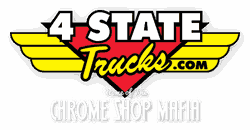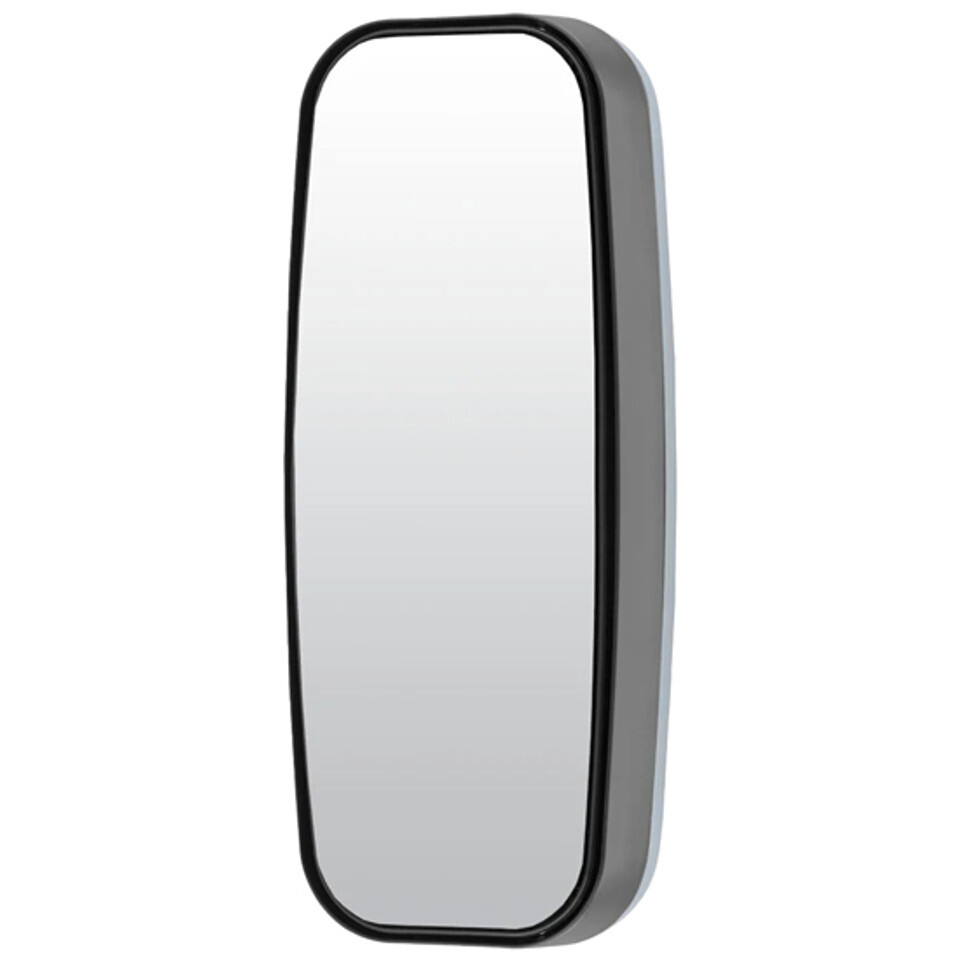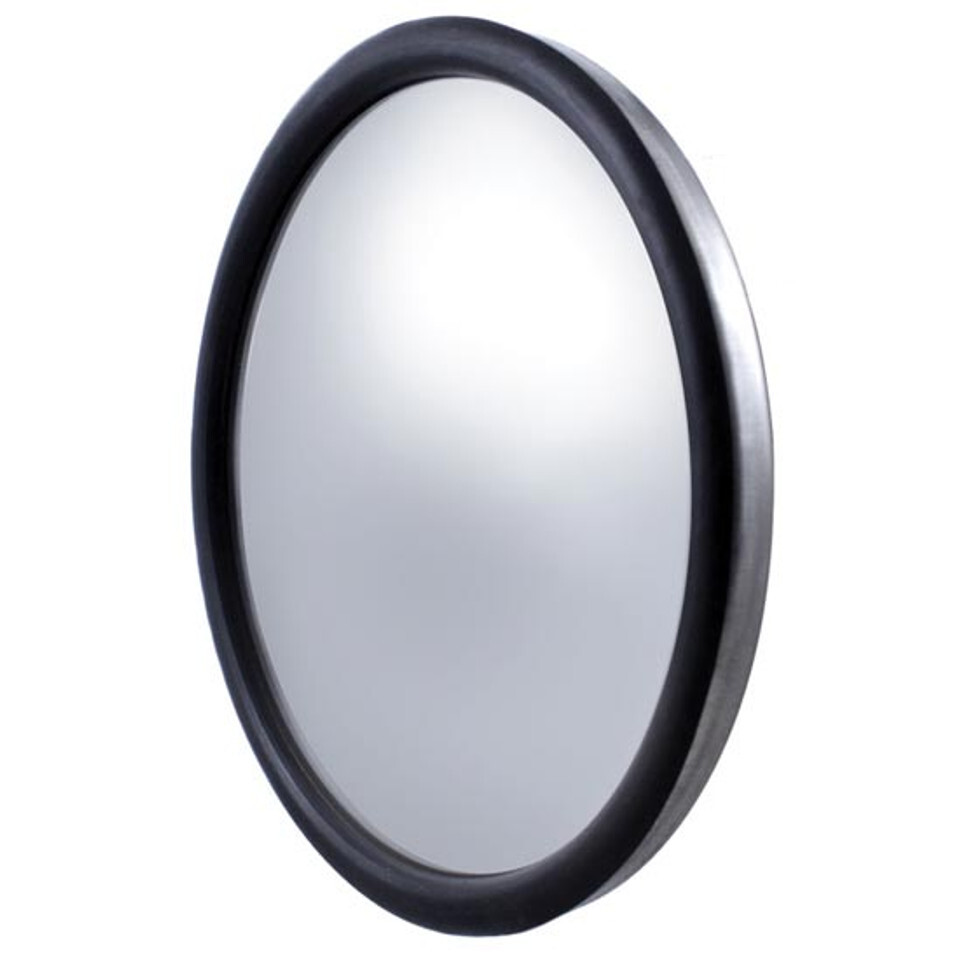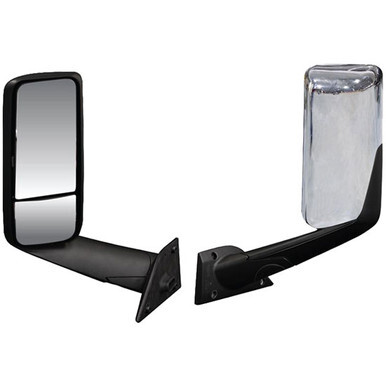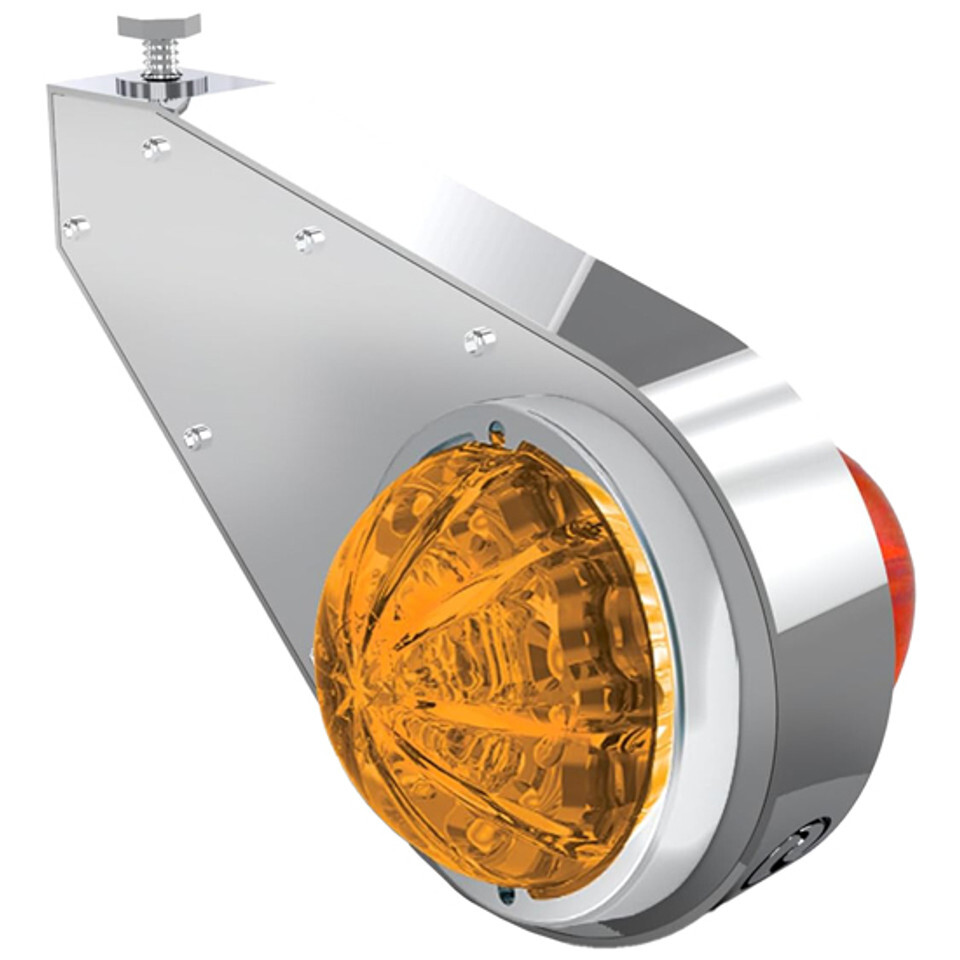Buyer's Guide to Aftermarket Semi Truck Mirrors (Styles, Housings, Brackets & Finishes)
Semi truck mirrors are crucial for maintaining clear visibility, reducing blind spots, and ensuring safe driving for drivers and other vehicles on the road.
Here’s an example.
Let’s say you’re looking to replace your OEM Peterbilt 379 mirrors with a high-quality aftermarket alternative; with so many options on the market, it’s good to have a solid reference guide to make the best choice possible, both for resale value and pricing.
Good news!
In this simple semi truck mirror guide, we’ll explore the various types of semi truck mirrors, their key features, and their materials.
Types of Semi Truck Mirrors Explained
Flat Mirrors
Flat mirrors are known as west coast mirrors and show an accurate reflection of the size and distance of objects while offering a narrower field of vision when compared to convex mirrors.
Convex Mirrors
Fish-eye mirrors or “wide angle mirrors” are commonly used as side mirrors or rear view mirrors which provide a wider field of vision and help to reduce blind spots. The objects in a convex mirror appear smaller than they really are thanks to the bulging curved shape of the mirror.
Sometimes they come attached to a single mirror kit, near the bottom, and sometimes they come separate as an oval, rounded-looking mirror (about 6 to 8 inches wide).
Extended-Length Planar Mirrors
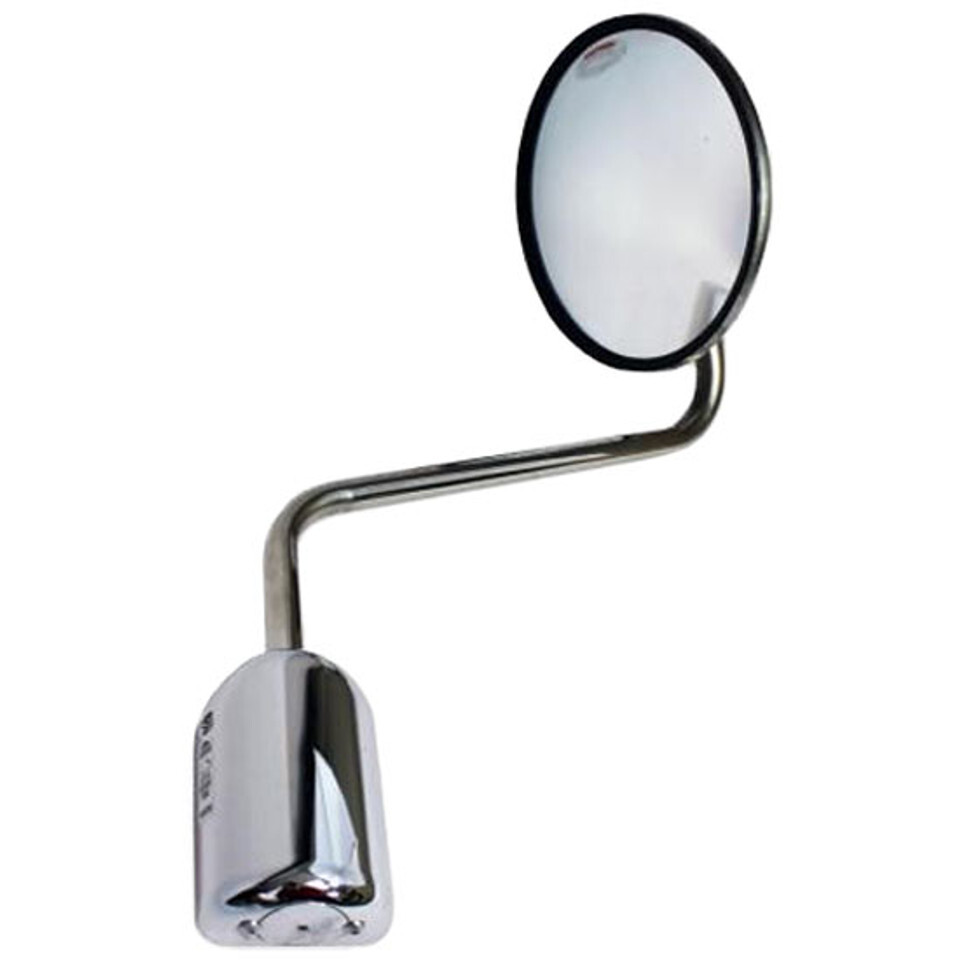
These mirrors have long, extended mirror arms to give a driver an even wider view of the road when hauling a large trailer. These help drivers see passing traffic.
Additional Mirrors (Blind Spot Mirrors)

Offset mount blind spot mirrors are typically convex mirrors that are small in size and attach to the existing side mirrors.
Heated Mirrors
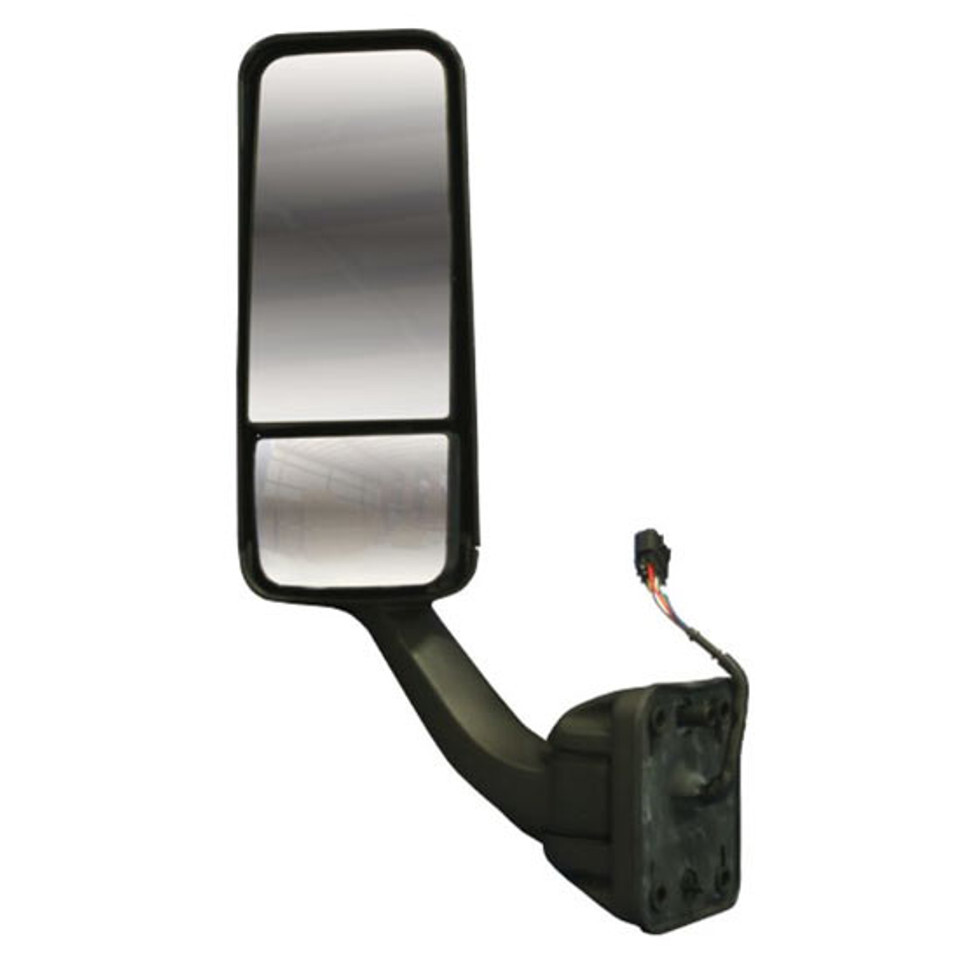
Heated mirrors prevent fogging and ice buildup through radiation heat transfer using a thin wire grid that’s inside of the mirror glass which connects to the semi truck’s electrical system. These are great for truckers operating in harsh weather conditions.
Semi Truck Mirror Housing Materials and Construction
The Most Common Mirror Materials
- Stainless Steel: sturdiest and longest-lasting material with heavier weight
- Aluminum: lightweight, corrosion-resistant material for a longer equipment life
- Polycarbonate: lighter weight and highly versatile
- Chrome: highly reflective, mirror-like finish that offers a more eye-catching, sleek appearance
Mirror Brackets and Assemblies
Brackets and assemblies are designed to withstand vibrations and rough road conditions, supporting the stability and visual accuracy of the mirror.
Mirror brackets can be door-mounted or cab-mounted.
When brackets are not installed correctly it can lead to:
- Blind spots
- Distorted or inaccurate reflections
- Excessive wear, tear, and damage from vibration
- Potential traffic citation and fees by non-compliance with state regulations
Proper mirror adjustment is critical for safe and accurate driving. Most semi truck mirrors offer an aerodynamic design to help reduce wind resistance and improve fuel efficiency. But when they aren't mounted accurately, they increase potential wind drag.
Mirror Bracket Materials
Normal and extension brackets are primarily made of durable steel material. However they can come in other materials as well.
- Stainless Steel: corrosion-resistant, durable, and heavier than aluminum
- Aluminum: lightweight, but doesn’t weaken over time
- Powder-Coated Steel: resists rust and corrosion
- Chrome-Plated Steel: visually appealing, but can rust over time
Mirror covers and chrome accent finishes offer a sleek look on truck models from the likes of Western Star and Kenworth.
Best Aftermarket Brands for Semi Truck Mirror Brackets
Moto Mirror is among the most widely-sold brands on the market today. It's sold by several aftermarket parts companies.
- Chrome Shop Mafia: A custom fabrication shop that creates parts like cab-mounted mirror bracket kits for Peterbilt.
- RoadWorks: Roadworks makes sleek, stainless steel mirrors and mirror accessories, like Peterbilt door window panels for door-mounted mirrors.
- Twelve Gauge Customs: A reputable semi truck parts manufacturer that offers sturdy paintable steel mirror brackets.
- BESTfit: 4 State-owned parts manufacturer that crafts chrome-finished, heated hood mirror arms and heated power mirror kits.
It's also important to look for customer reviews and gather more information if you're looking to upgrade to a new aftermarket mirror brand, even if it’s word of mouth.
Your replacement mirror will depend on the mounting bracket setup that's already in place. While the majority of hood mirrors are universal, easily applied to nearly any heavy-duty truck hood, most truck models have their particular mirror mount positioning.
Take the Freightliner Cascadia as an example.
You can see that the mounting is entirely different than the Kenworth T680 or the Peterbilt 359.
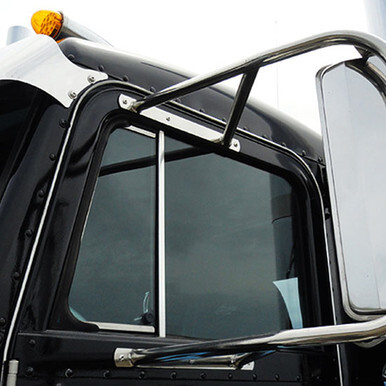
Top Considerations When Purchasing an Aftermarket Semi Truck Mirror
If you're just getting a replacement, it's straightforward. Swap the old mirror glass out for the new, and leave the housing and brackets. Find the aftermarket mirror kit that has the same specs as your OEM or current in-use one.
But if you want a new setup, you'll probably need a completely new mirror setup, which means new brackets and a new cutout on your exterior cab to mount the lights.
The choice still comes down to style preference, whether it's rounded, oval, or squared-of, offset or direct mounting configuration, or light-backing or no light-backing setup, and whether or not the mirrors fit your truck make: Freightliner, Volvo, International, Peterbilt, Kenworth, or Western Star.
Flat vs Convex Truck Mirrors
A Flat mirror is best used when you need an accurate view of the surrounding area in order to better maneuver the rig and judge clearances.
However, a convex mirror is better for a wider field of view when observing traffic in adjacent lanes and near the rear of the trailer.
Some mirror housings come with both a flat mirror and the convex, wide-view mirror attached at the bottom.
Material Quality of Your Truck’s Mirror
Choose high-quality housing materials like stainless steel or reinforced polycarbonate to ensure your mirror assembly is durable for years to come.
Installing and Adjusting Your Truck Mirror
Depending on the manufacturer, most mirrors are easy to fit, install, and adjust for optimal performance. Most of the time, when you buy an OEM-replacement or its complementary aftermarket alternative, the housing and mounting positions stay the same. So it's fairly easy to install.
But when you have a new offset mounting placement, you'll need to measure the base of the mirror kit's mounting, then cut out a new spot on the cab to mount it.
Adjusting your semi truck mirrors is easy.
Position the flat mirrors so you can see the rear corners of the truck, then tilt them up or down till you can see the rod and trailer in the bottom edge of the mirror. Put the convex mirrors down as far as possible to max out your visibility.
Compliance with State Laws
Mirrors should meet state regulations for safety and visibility, whether it’s Missouri, Texas, or California, which include length standards for bracket-extended wide-view mirrors among other things.
Upgrading and Replacing Your Semi Truck Mirrors
Mirror Replacement Depends on the Mounting Bracket Setup
Your mounting bracket configuration depends on the make and model of your truck.
Hood-mounted mirror assemblies, and most fender-mounted mirrors, are pretty much universal, easy to fit on any nearly class 8 truck model you have.
The Freightliner Cascadia is a truck model that requires a very specific mirror set, simply due to its mounting configuration on the truck.
Many Peterbilt or Kenworth models, on the other hand, have two mounting spots.
If you’re replacing one mirror kit with another that has a different mounting setup, you’ll need new cutouts to your door or cab - depending on where it’s being positioned.
Aftermarket Mirror Kit Accessory Upgrades
Upgrading to an advanced mirror system can include adding additional mirrors, wide-angle or fish-eye mirrors, or just getting a set of heated mirrors.
There are plenty of aftermarket mirror accessories to help extend the functionality of your mirror assembly, including items like the 2-inch nut cover mirror extension kit, which helps to extend the visual scope of your mirror after you’ve installed thick exhaust stacks on the side of your rig.
There are a myriad of other, more advanced tech-laden accessories that can radically upgrade your mirror setup.
Keep in mind, it’s just a question of whether or not you want to invest your hard-earned dollars into additional features like:
- Electrochromic Glass: glass that changes tint or opacity to mitigate glare from sunlight or headlights.
- LED Illuminated Glass: integrated within and around the edges of the mirror glass itself to improve visibility during low-light conditions.
- Remote Control Adjustment: these mirrors allow for remote adjustment of the position via buttons or joysticks within the cab, saving time when compared to manually adjusting mirrors.
At 4 State Trucks, we offer more basic, essential accessories like mirror assemblies with LED-back lighting, or attachable LED light bars for side mirrors. Or, additional watermelon mirror light brackets that attach below the mirror mounts.
Signs of a Low-Quality or Worn-Out Mirror Bracket
- Excessive vibrations: poor bracket construction or loose mounting hardware
- Misalignment issues: weakened bracket cannot hold the mirror in place
- Loose movement: shifting positions after minor vibrations
Common Issues With Truck Mirrors
Misalignment
Issues: improper installation of the mirrors can create blind spots
Solutions: regular inspection and adjustment of mirror brackets and mounting hardware
Visibility and Stability
Issues: excessive vibrations from worn-out brackets
Solutions: Buy durable assemblies from quality vendors who are known for not compromising part quality for profitability, and inspect the mirror for signs of wear or loose attachments
Fogging and Contaminants
Issues: reduces visibility from dirt, debris, or fog
Solutions: regularly clean the mirrors and maintain them correctly
Rust and Corrosion
Issues: Rust weakens the mirror assembly
Solutions: avoid using harsh chemicals; use soft cloth for cleaning and perform regular inspections
General Cleaning Tips for Mirrors
- Regular cleaning and inspection: once a week, using a soft cloth and mild glass cleaner.
- Check for damage and replacements: cracks, chips, or loose mounts.
- Prevent rust and corrosion: keep mirrors dry as much as possible or use protective covers.
Tip: Always use a mild, ammonia-free glass cleaner and spray it directly on the cloth - NOT onto the mirror. Then, wipe in a circular motion.
You can use a simple vinegar and water mix. But if you need an automotive glass cleaner, the BullSnot glass cleaner is an excellent choice.
Final Considerations When Before Buying Aftermarket Semi Truck Mirrors
Truck mirrors are essential for safe, functional driving. With so many options, it’s important to have the right knowledge before making a choice on which mirror to buy for your truck.
Check customer reviews and ask a qualified product sales rep about what you’re looking for so they can give you more insight into the right mirror kits for your budget, style, and truck model. If you have specific questions about the type of mirror you're looking for, give one of our team members a call today.
Recent Posts
-
3 Epic Air Cleaner Light Panels for Your Kenworth W900 Truck
When it comes to customizing a Kenworth W900, some truckers love adding as many addtional light …14th Apr 2025 -
5 Killer Axle Cover Styles to Personalize Your Semi Truck
Semi truck axle covers protect the exposed axle housing from dirt and road debris while offerin …14th Apr 2025 -
5 Unique Lug Nut Cover Styles to Give Your Truck a More Polished Look
Semi truck lug nut covers aren’t just useful in protecting your lug nut and wheel studs, …14th Apr 2025 -
Top 4 Semi Truck Power Inverters to Fully Charge Your Appliances
Semi truck power inverters are critical for truckers who need more comfort, productivity, safet …31st Mar 2025 -
Top Semi Trucks Owned in Each State (Data for All 50 States)
Here's some visual data on the most commonly owned heavy duty semi truck models based upon four top …26th Mar 2025 -
Best Sleeper Cab Upgrades for Comfortable Long-Haul Trucking
A comfortable sleeper cabin space can improve your rest, well-being, and productivity on the road. I …14th Mar 2025 -
How to Customize Your Peterbilt 379 with Aftermarket Parts (Within a Budget)
The Peterbilt 379 truck is an iconic, bold, and rugged-looking classic, beloved among owner-operator …13th Mar 2025 -
Peterbilt 379 Short Hoods vs Long Hoods
Your Peterbilt 379 hood is more than metal—it’s a statement. If you’re comparing p …12th Mar 2025 -
Are Semi Truck Grille Guards Worth the Money?
Ever seen another truck driver barreling down the highway with a 14-gauge stainless steel or chrome …7th Mar 2025 -
What are the Best West Coast Mirror Styles for Semi Trucks?
The West Coast mirror has been a staple of commercial trucks since trucking started. Constructed for …6th Mar 2025
